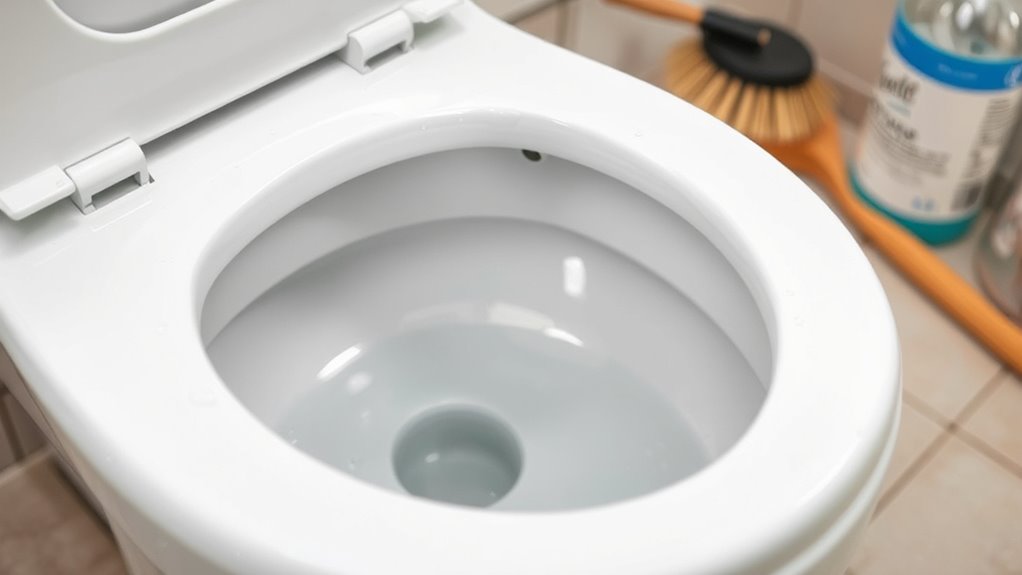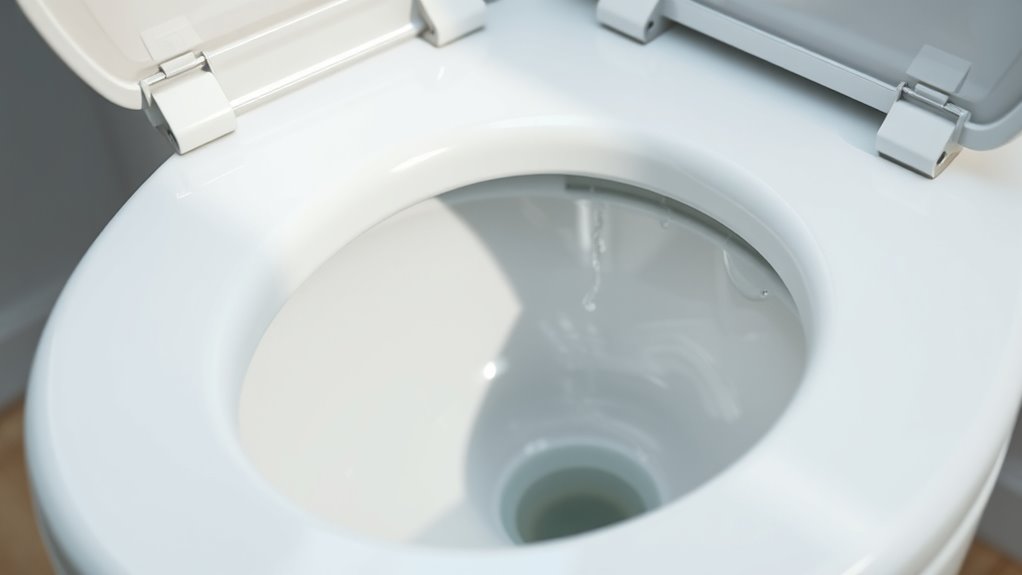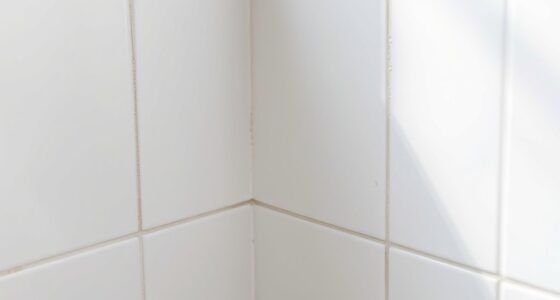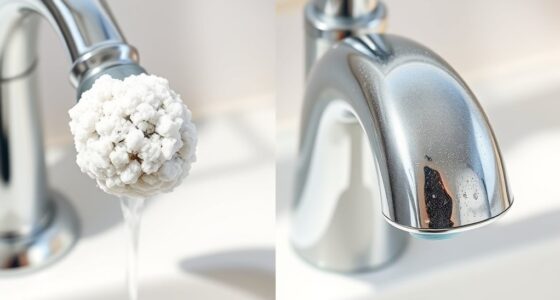To stop bathroom odors at the source, regularly deep clean your toilet tank by removing mineral deposits, mold, and bacteria. Turn off the water supply, drain the tank, and scrub all surfaces with vinegar or a specialized cleaner. Pay attention to areas prone to buildup, like the siphon holes and corners. Clearing obstructions and disinfecting prevents odors and ensures smooth flushing. Keep your tank clean, and you’ll enjoy a fresher bathroom—detailed steps await if you want to tackle this effectively.
Key Takeaways
- Regularly clean the tank with disinfectants or vinegar to eliminate microbial growth causing odors.
- Remove mold, bacteria, and mineral deposits that contribute to unpleasant smells.
- Clear mineral buildup and blue stains to prevent odor-causing residues from developing.
- Inspect and clean siphon holes and fill valves to ensure proper water flow and odor prevention.
- Maintain consistent deep cleaning to stop odors at the source and keep the toilet fresh.

A thorough deep clean of your toilet tank is essential to prevent buildup of mold, bacteria, and mineral deposits that can cause odors and reduce flushing efficiency. Over time, mineral deposits like hard water stains can develop, leading to unsightly blue stains that not only look unpleasant but can also interfere with the tank’s function. Blue stains are often caused by cleaning agents or minerals in the water reacting with the tank’s surfaces. Removing these stains isn’t just about aesthetics; it helps keep your toilet functioning properly. To effectively eliminate blue stains, you’ll need to scrub the tank’s interior with a brush and use a suitable stain removal solution, such as vinegar or a specialized cleaner designed for mineral deposits. This process restores the tank’s appearance and can prevent the buildup from worsening over time. Regular cleaning also helps maintain the overall health of your toilet’s flush mechanism, preventing issues caused by mineral buildup. Flow obstruction is another common issue that can stem from neglected tank cleaning. Mineral deposits and mold can form around the float, fill valve, or within the siphon holes, causing partial or complete flow obstruction. When water flow is obstructed, your toilet might not flush properly, leading to repeated attempts and increased water usage. To address this, you should first turn off the water supply and drain the tank. Then, inspect the fill valve and siphon holes for any blockage. Using a small brush or toothpick, carefully clean out any debris or mineral buildup obstructing the flow. This ensures smooth water movement during flushing, improving efficiency and preventing odors caused by stagnant water or mold growth. A deep clean isn’t just about removing stains and clearing obstructions; it’s about stopping odors at the source. Mold, bacteria, and mineral deposits thrive in the damp, dark environment of your tank, releasing unpleasant smells. Regularly cleaning the tank with disinfectants or vinegar helps eliminate these microorganisms, ensuring a fresher bathroom experience. Pay close attention to areas prone to buildup, like the corners and around the flush mechanism. By maintaining a clean tank, you prevent odors from seeping into the bathroom and keep your toilet functioning at its best.
Frequently Asked Questions
How Often Should I Deep Clean My Toilet Tank?
You should deep clean your toilet tank every six months to maintain proper tank maintenance and guarantee fresh water. Regular cleaning frequency prevents buildup of mold, mildew, and bacteria that cause odors. If you notice persistent smells or mineral deposits, increase cleaning intervals. Use a brush and gentle cleaner to scrub the tank’s interior, paying attention to corners and components. Proper maintenance keeps your toilet functioning well and smelling clean.
Can I Use Bleach to Clean the Toilet Tank?
Yes, you can use bleach to clean your toilet tank, but be mindful of bleach safety. Use a small amount and avoid mixing it with other cleaners to prevent harmful fumes. If you’re concerned about harsh chemicals, consider alternative disinfectants like white vinegar or hydrogen peroxide, which are effective and gentler on your plumbing. Regularly cleaning your tank helps stop smells at the source and keeps your toilet fresh.
What Are Natural Alternatives for Cleaning the Tank?
You can use plant-based solutions and vinegar remedies to clean your toilet tank naturally. Try pouring white vinegar into the tank and letting it sit for a few hours to dissolve buildup and eliminate odors. You can also add baking soda for extra freshness. These natural alternatives are effective, eco-friendly, and free from harsh chemicals, helping to keep your toilet fresh without relying on bleach or synthetic cleaners.
How Do I Prevent Mold and Mildew Buildup?
To prevent mold and mildew buildup, you should regularly clean your toilet tank and keep it dry. Use natural mold prevention methods like vinegar or baking soda to inhibit mold growth and guarantee good ventilation in your bathroom for mildew control. Check for leaks or excess moisture, and consider installing a dehumidifier if needed. Consistent maintenance and moisture management are key to keeping mold prevention and mildew control effective.
Are There Eco-Friendly Cleaning Methods for Toilet Tanks?
Think of eco-friendly cleaning as tending a garden—you want to nurture it without harmful chemicals. You can use biodegradable cleaners and vinegar solutions to clean your toilet tank effectively, breaking down grime and odors naturally. These methods are gentle on the environment while keeping your toilet fresh. Just pour vinegar or eco-friendly cleaners into the tank, scrub lightly, and enjoy a clean, odor-free toilet without any harsh chemicals.
Conclusion
A deep clean of your toilet tank is the best way to eliminate stubborn odors at their source. Even if it seems time-consuming, you’ll notice fresher air and a cleaner bathroom overall. Plus, regular maintenance prevents buildup and future smells, saving you hassle down the line. Don’t ignore that lingering smell—invest a few minutes now, and enjoy a fresher, cleaner toilet without harsh chemicals or repeated cleanings. Your nose—and your bathroom—will thank you.








